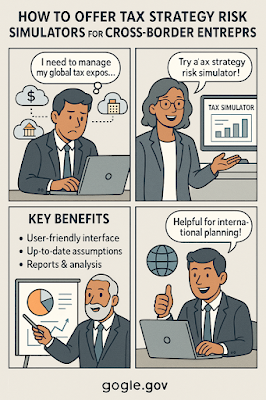How to Offer Tax Strategy Risk Simulators for Cross-Border Entrepreneurs
How to Offer Tax Strategy Risk Simulators for Cross-Border Entrepreneurs
Helping cross-border entrepreneurs navigate the complexities of international tax systems is both a massive challenge and an opportunity for innovation.
One of the smartest ways to support them is by offering tax strategy risk simulators that model different outcomes depending on country, transaction, and income structures.
In this guide, we will explore how to design and launch tax simulators that truly help entrepreneurs mitigate risks and make better decisions globally.
Table of Contents
- Why Tax Simulators Matter for Global Entrepreneurs
- Key Design Principles for Risk Simulators
- Must-Have Features in Tax Risk Simulators
- Real-World Compliance Considerations
- Best Practices for Offering Simulators
- Conclusion
Why Tax Simulators Matter for Global Entrepreneurs
Cross-border entrepreneurs often face a maze of tax obligations, from double taxation treaties to permanent establishment risks.
Without a clear view of their exposure, they risk unexpected tax bills, audits, and penalties.
Tax strategy simulators offer predictive insights, helping users evaluate different legal structures, countries of incorporation, and cross-border transaction methods.
Key Design Principles for Risk Simulators
Building an effective simulator requires precision and simplicity.
First, the user interface must be intuitive—tax law is complicated enough already without adding confusing design.
Second, the underlying assumptions (e.g., tax rates, thresholds) must be updated regularly with jurisdictional changes.
Third, clear disclaimers are essential to clarify that results are educational and not personalized tax advice.
Must-Have Features in Tax Risk Simulators
At a minimum, your simulator should allow users to:
Input multiple countries of residence and income sources.
Estimate effective global tax rates under various legal structures (LLC, C-Corp, etc.).
Model transfer pricing risks for related party transactions.
Simulate VAT/GST exposure based on product sales locations.
Access real-time treaty benefits analysis.
Additionally, offering downloadable reports helps entrepreneurs share findings with advisors or investors.
Real-World Compliance Considerations
Regulatory compliance must be embedded from the start.
Depending on where you operate, offering tax simulators could classify you as a financial service provider, triggering licensing or disclosure obligations.
For instance, in the U.S., fintech companies offering tax calculation tools must adhere to IRS guidelines on digital recordkeeping and privacy rules under the Gramm-Leach-Bliley Act (GLBA).
Consult with compliance experts to ensure your platform remains on the right side of regulatory expectations.
Best Practices for Offering Simulators
To successfully deploy tax risk simulators:
Offer a free basic version with upsell options for deeper analysis.
Incorporate country-specific tax alerts for proactive user notifications.
Collaborate with accounting firms to co-brand the simulator and extend trust.
Ensure multi-language support if targeting global entrepreneurs.
Continuously collect user feedback to refine assumptions and UX/UI.
Conclusion
Cross-border entrepreneurship is booming—and tax complexity is not slowing down.
Offering a well-designed tax strategy risk simulator can empower entrepreneurs to plan smarter, reduce liabilities, and grow confidently across jurisdictions.
Whether you're a fintech startup, a tax advisory firm, or a legaltech platform, integrating simulator technology is quickly becoming a must-have competitive advantage.
By integrating smart risk simulation tools, you can lead the future of tax planning for today's increasingly borderless entrepreneurs.
Keywords: tax strategy simulator, cross-border entrepreneurship, international tax planning, fintech compliance, risk management tools
